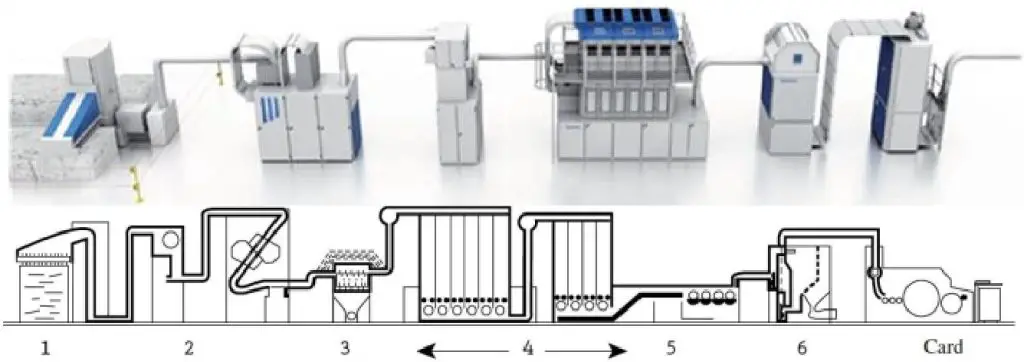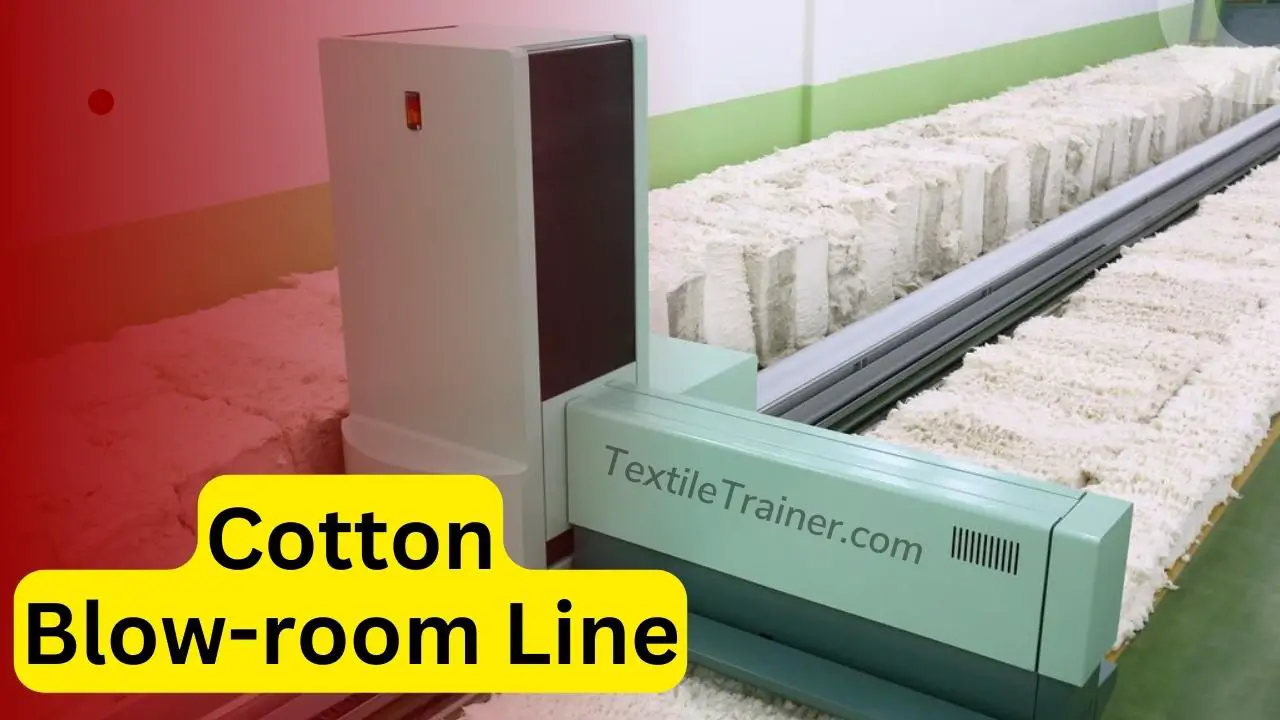What is Blow Room?
The blow room in textile manufacturing is a specialized section or department where raw fibers, such as cotton, polyester, or wool, undergo a series of mechanical processes to achieve a number of objectives. As part of the fiber-to-yarn conversion process, it plays a vital role in preparing the fibers for subsequent manufacturing processes. A blow room is defined as a designated area with various machines and equipment for opening, cleaning, blending, and controlling fibers. The primary goals of blow room process are:
- An impurity removal process.
- An open bale of compressed fibers.
- A homogeneous fiber blend.
- A condition that allows the fibers to be processed optimally.
In summary, the blow room is where the compressed bales are transformed into uniform laps of specific length by opening, cleaning, blending, or mixing to transform them into a uniform lap.

Objectives of Blow room:
In the textile industry, the blow room is an integral part of the spinning process. It is primarily responsible for processing raw cotton fibers and preparing them for further processing in a spinning mill. As an intermediary between cotton bales and the carding machine, the blow room ensures that impurities are removed, fiber tufts are opened, and fiber properties are uniform. The following are the objectives of the blow room:
- Opening: Opening is a vital part of the blow room process. The raw material we use to produce yarn is bale. Bales are fiber packages that are highly compressed and dense (450kg/m3) when loaded and contain about 40-50 billion fibers. In contrast, the yarn density varies from 0.40 gm/cm3 to 0.85 gm/cm3 and the cross section contains 35-150 fibers, depending on its count. Due to the shape of the cross section of the fiber package from bale to yarn, comparing reduction of volumetric density is not appropriate. Therefore, reducing phenomena need to be handled in the blow room.
- Cleaning: Bales of natural fiber contain more impurities than bales of manmade fiber. These impurities can hinder the formation of a proper yarn structure and adversely affect the yarn quality. In order to reduce impurities to a minimum level, cleaning operations are required. Cleaning technology and cleaning point are different depending on the type and size of impurities. For color impurities, we use optical technology to scran and air blow to clean, and for metallic impurities, we use magnets to separate.
- Preparation of Card Feed Materials: The card feed material requires a special preparation treatment, which is carried out in the blow room, because poor-quality card feed material will hamper the main objective of the card frame, namely individualization of fibers, which in turn will adversely affect spinning.
Importance of Blow Room:
The first working zone in short staple spinning is the blow room. In this section, the first and preliminary predominance of mechanical load is applied to fiber in an enormous way. The blow room is therefore an important section of short staple spinning in terms of its technical aspects. It is possible to discuss the importance of the blow room from the following perspective:
- In view of processilization: In short staple spinning, raw materials are received in the form of a package of highly dense material under a high compressive load for the production of yarn. There needs to be intensive opening and cleaning to reduce density of a bale of 220 kg with a diameter ranging from 0.10 mm to 2.0 mm and weighting 10.0-50.0 g/km. Another important point, number of fiber in yarn cross section ranges 35-150 where as a bale contains approximately (4.0 ×1010 fibers. This phenomenon need opening, cleaning, weight reduction and these operations are carried out in blow room at multiple process stages to prepare the material at suitable form for carding machine.
- In view of mechanical stress: from the view point of quality, stresses loaded on fibers bear significant role. Stressing on fibers during processing on blow room machines plays considerable negative effect on fiber properties, especially strength, fiber length, neps and elasticity. From experiment it is seen that for one more machine than necessary in blow room short fiber increases about 10% and neps generation is noticeably high.
- In view of product cost: considering the overall costs of a ring spinning plant, the share of the blow room line within approximately 5 to 10%, is not very significant. But analyzing the cost structure of a yarn in which the raw material accounts for about 50-70%, it produces a clear picture of understanding that it is better way to reduce costs through the raw material. In this respect blow room is very important, in the respect of raw materials treatment, e.g the avoidance of deterioration and optimum preparation for further processing as well as the best possible utilization or realization. With the introduction a modern high-performance blow room line, it enables a somewhat cheaper material to be used with better treatment of rwa matrial than with an older blow room line. In the respect of better utilization or realization of raw material, the amount of wastage removed in blow room play important role in evaluation of product cost. This concept is related to quality attribute of the product also. A change in wastage in increasing order from the optimal level effets in yarn cost and yarn realization negatively. But the change in wastage in decreasing order from the optimal level effect in yarn quality and meeting the customer complaint negatively also.
- In view of product quality. To understand the importance of blow rom in view of product quality, we have to look into the following parameter:
- About 50% of all shortcomings in the yarn:
- About 50% of all quality reducing factors; and
- About 50% of all breakage in spinning process
Causes can be traced back to the operation of the blow room and cards.
All the above mentioned problems are exposed because of off standard operation due to an off-standard blow room line or off-standard technical setting in blow room along with card frame. This implies the significance of the role of standard blow room line
Conclusion:
It is essential to successfully process raw cotton fibers that the blow room section in the textile industry serves critical objectives. As part of its role in preparing fibers for spinning processes, the blow room focuses on fiber opening, cleaning, distribution, length control, waste removal, and dust control. The blow room’s objectives are integral to the success of the spinning process in the textile industry. Ultimately, the blow room contributes to manufacturing superior textile products by producing consistently high-quality yarn.
References
- Belal, P. D. (2009). Understanding Textiles for a Merchandiser . Dhaka: L. B Graphics and Printing.
- Chowdhury, M. F. (2016). Manual of Short Staple Spinning. Dhaka: Granthanir Prokashoni.
- Corbman, D. P. (1983). Textiles Fiber to Fabric. NewYork: Mary McGarry.
- Hossain, M. S. (2014). Introduction to Textile Engineering. Dhka: Books Fair Publications.
- Principles of short staple spinning (Volume-1) by Prof. Dr. Engr. Ayub Nabi Khan
- The Technology of Short-staple spinning by W. Kelin







Looking forward to reading more. Great article post.Really thank you! Will read on…
thanks.
Thank you for your article.Thanks Again. Really Cool.
keep visit our site….
Thanks for the post.Really looking forward to read more.
thanks too..
I value the blog. Really Great.
Keep visit our site..
I really enjoy the article.Really looking forward to read more. Awesome.
Keep visit our site…
Thanks-a-mundo for the article post.Thanks Again. Really Cool.
thanks too……please support us….
I value the blog.Thanks Again. Cool.
ok….please share our article…
A big thank you for your blog post.Really looking forward to read more. Keep writing.
ok…keep visit our site.
Thanks so much for the blog post. Really Cool.
keep visit our site.
Im obliged for the post.Thanks Again. Awesome.
Great, thanks for sharing this article.Really looking forward to read more. Really Great.
Very informative blog post. Really Cool.
Thanks-a-mundo for the post. Will read on…
Thanks again for the post.Much thanks again. Really Great.
I am so grateful for your post.Thanks Again. Great.
I value the blog post. Really Great.
keep visit our site.
Really enjoyed this blog post.Really looking forward to read more. Really Great.
keep visit our site.
Very good article.Really thank you! Really Cool.
I really enjoy the blog.Really thank you!
Really appreciate you sharing this article post.Thanks Again. Awesome.
I really liked your post.Thanks Again. Really Cool.
A big thank you for your post.Really looking forward to read more. Want more.
Thank you
Wow, great blog article.Really thank you! Fantastic.
Say, you got a nice blog post.Thanks Again.
Great blog.Much thanks again. Keep writing.
Muchos Gracias for your blog.Much thanks again. Really Great.
Great, thanks for sharing this post.Thanks Again. Really Great.
Thanks again for the blog article.Really looking forward to read more. Great.
Thank you ever so for you article post. Really Great.
Great, thanks for sharing this blog article. Awesome.
A round of applause for your blog.Thanks Again. Cool.
Say, you got a nice blog post.Really thank you! Really Cool.
Im thankful for the blog article. Want more.
Thanks a lot for the blog article.Thanks Again. Really Cool.
Very informative article.Really thank you! Really Cool.
Appreciate you sharing, great article post.Much thanks again. Cool.
I loved your article post.Really thank you! Great.
Thanks a lot for the article post.
Major thankies for the blog.Really thank you!
Hey, thanks for the blog post.Much thanks again. Awesome.
Thank you for your blog. Fantastic.
Really informative article.Much thanks again. Great.
Fantastic article post.Thanks Again. Awesome.
Very good blog article. Awesome.
I really like and appreciate your post.Thanks Again. Cool.
Really appreciate you sharing this blog post.Much thanks again. Really Great.
I really liked your article post.Thanks Again.
Thanks for sharing, this is a fantastic blog article.Really thank you! Great.
Say, you got a nice article.Much thanks again. Really Cool.
I really enjoy the blog article.Much thanks again. Want more.
Very good post.Thanks Again. Awesome.
Thanks so much for the post.Really thank you! Really Great.
Wow, great post.Really looking forward to read more. Much obliged.
I really like and appreciate your blog post.Really thank you! Awesome.
Thanks so much for the post.Really looking forward to read more. Much obliged.
I think this is a real great post.Much thanks again. Keep writing.
Great, thanks for sharing this blog. Really Great.
I loved your article.Really looking forward to read more. Awesome.
Hey, thanks for the blog post.Thanks Again.
I loved your article post.Really thank you! Much obliged.
Thanks again for the blog.Thanks Again. Great.
I really enjoy the article post.Thanks Again. Want more.
Thanks for sharing, this is a fantastic article post.
Major thanks for the article post.Really looking forward to read more. Fantastic.
I really liked your post.Thanks Again.
Say, you got a nice article post.Really thank you! Keep writing.
I value the blog.Really thank you!
Hey, thanks for the blog post.Really looking forward to read more. Really Great.
Major thanks for the blog post.Thanks Again. Awesome.
Appreciate you sharing, great blog post.Thanks Again. Want more.
Really enjoyed this blog post.Much thanks again. Cool.
Im grateful for the article post. Much obliged.
Thank you for your blog.Thanks Again. Great.
I really liked your blog post.Thanks Again. Great.
Thank you ever so for you blog article.Much thanks again. Great.
I truly appreciate this blog post.Thanks Again. Awesome.
Very neat blog article.Thanks Again.
wow, awesome article post. Great.
Appreciate you sharing, great blog post. Really Cool.
I really liked your article post.Thanks Again. Want more.
Thanks so much for the blog article.Thanks Again. Want more.
I really enjoy the blog article.Thanks Again. Want more.
I really like and appreciate your blog article. Much obliged.
A big thank you for your blog.Much thanks again. Much obliged.
A big thank you for your article post.Really looking forward to read more. Much obliged.
Very good blog post.Really thank you!
Say, you got a nice blog.Really looking forward to read more. Want more.
Thanks a lot for the article.Really thank you! Cool.
Great blog post. Really Great.
Very informative post. Great.
wow, awesome article.Thanks Again. Great.
Great, thanks for sharing this article.Really looking forward to read more. Great.
Very informative blog post.Thanks Again.
I loved your article. Awesome.
Enjoyed every bit of your article.Thanks Again. Fantastic.
Awesome post.Really thank you! Much obliged.
Im thankful for the blog post.Thanks Again. Want more.
I think this is a real great blog post.Much thanks again.
I really liked your post.Much thanks again. Keep writing.
I really like and appreciate your post. Cool.
Im thankful for the article.
Major thanks for the blog article.Thanks Again. Really Great.
Really enjoyed this article.Much thanks again. Much obliged.
Major thankies for the post.Much thanks again.
Thanks too
I appreciate you sharing this post.Really looking forward to read more. Will read on…
I cannot thank you enough for the blog post.Really looking forward to read more. Much obliged.
Enjoyed every bit of your blog article. Much obliged.
Hey, thanks for the blog.Thanks Again. Want more.
Awesome blog post.Really thank you!
I loved your post.Thanks Again. Keep writing.
Enjoyed every bit of your blog post.Really looking forward to read more.
Very informative blog article.Really thank you! Really Great.
I really liked your post.Really looking forward to read more. Great.
I think this is a real great blog article. Awesome.
Very good blog article.Really thank you! Will read on…
Awesome post.Much thanks again. Awesome.
Very neat blog.Thanks Again. Fantastic.
Thanks for the article.Thanks Again. Awesome.
Thanks so much for the article.Really thank you!
Im obliged for the article.Really looking forward to read more. Much obliged.
Thanks again for the article. Great.
Really appreciate you sharing this post.Much thanks again.
Thank you for your blog article.Much thanks again. Really Cool.
Kerassentials are natural skin care products with ingredients such as vitamins and plants that help support good health and prevent the appearance of aging skin. They’re also 100% natural and safe to use. The manufacturer states that the product has no negative side effects and is safe to take on a daily basis.
Enjoyed every bit of your blog post.Really thank you! Awesome.
Thanks again for the blog post.Really looking forward to read more.
A big thank you for your blog.Much thanks again. Great.
Im grateful for the post.Much thanks again. Will read on…
wow, awesome article.Thanks Again. Want more.
Major thanks for the blog.Really looking forward to read more. Will read on…
I really enjoy the article.Thanks Again.
I value the article post.Much thanks again. Really Cool.